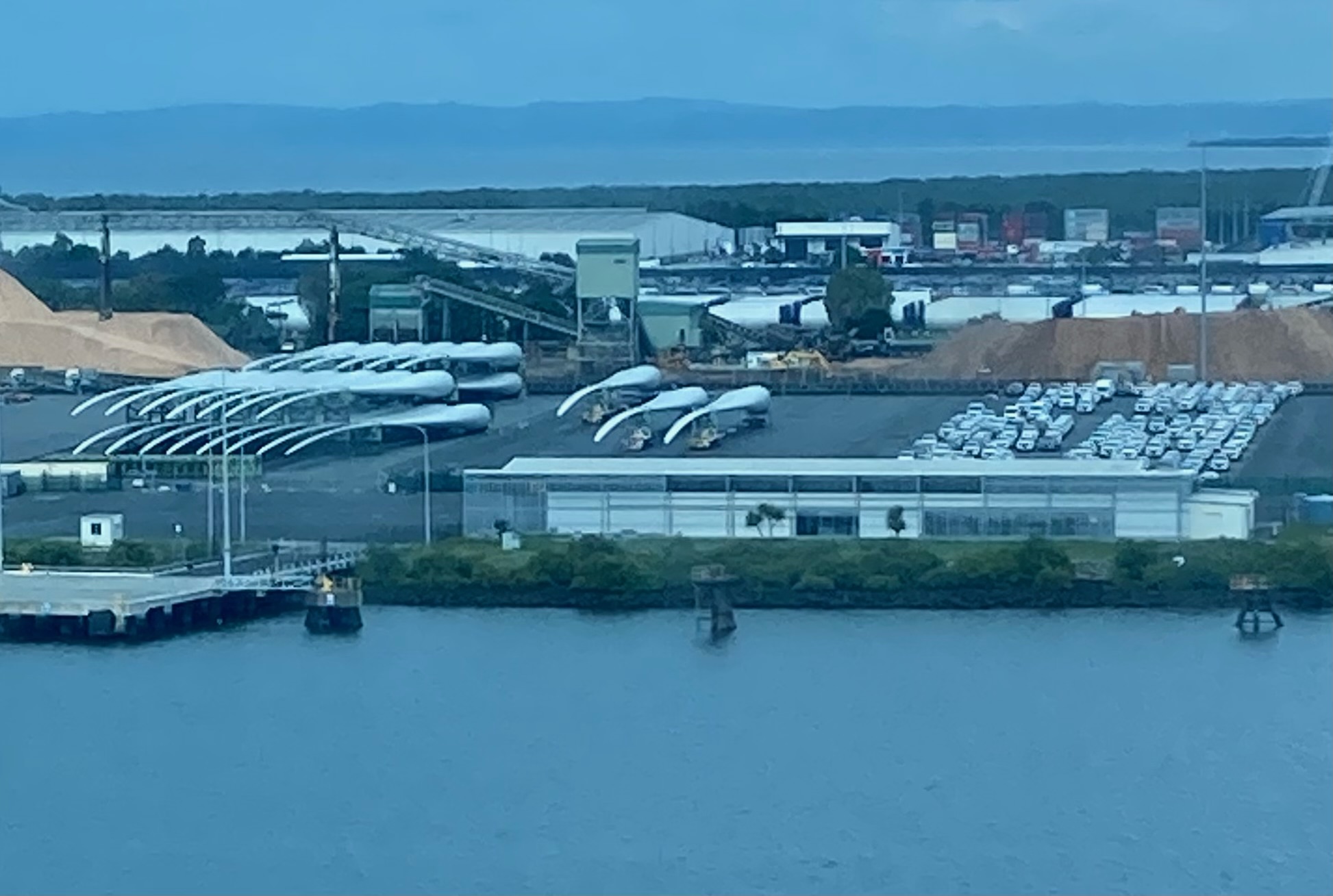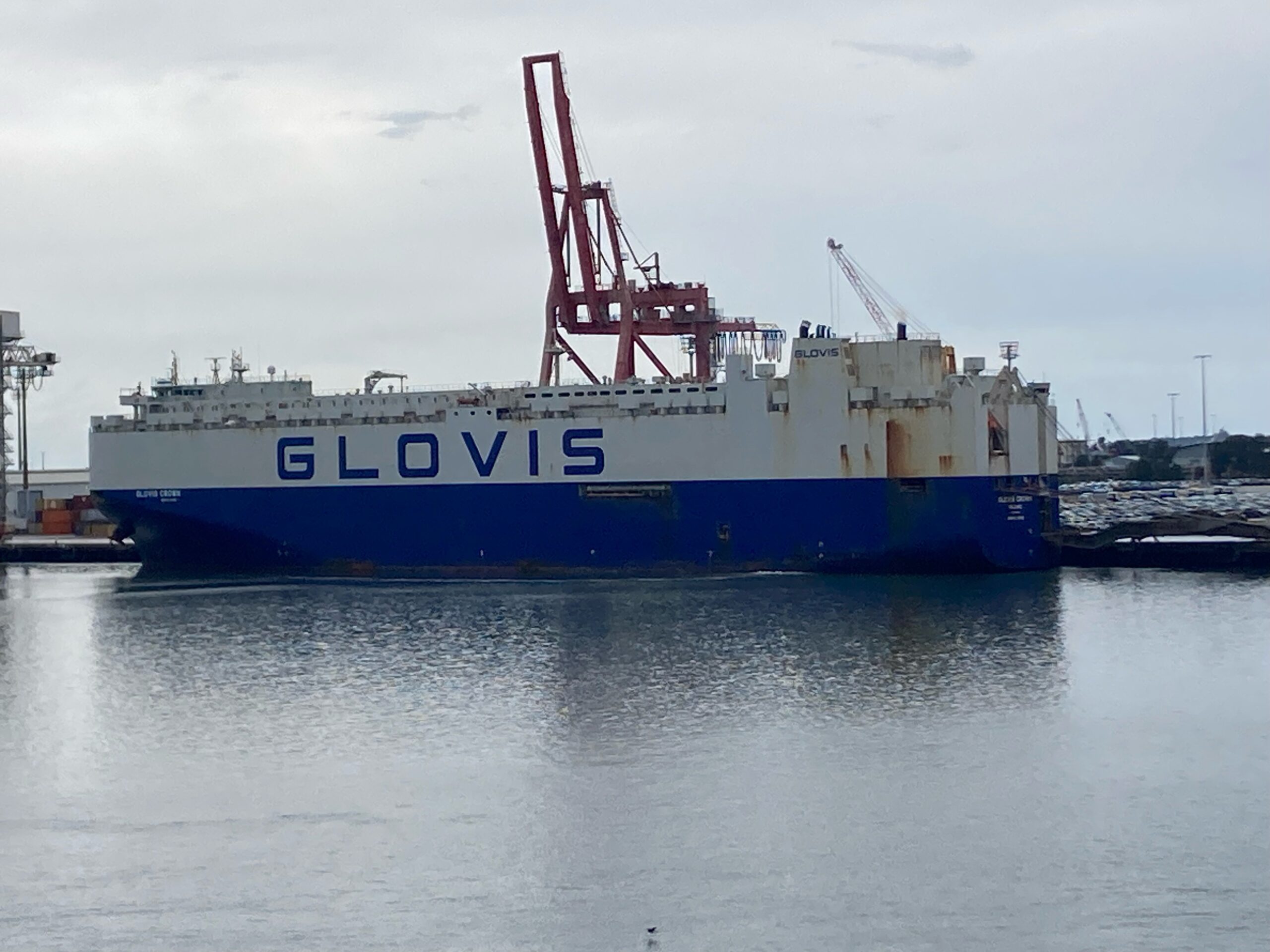Sign up for daily news updates from CleanTechnica on email. Or follow us on Google News!
A glance at the open National Electricity Market widget tells the story of Australia’s energy transition. We are still dependent on coal for almost half of our generation needs. Solar is major, wind power is minor. Gas is a constant irritation. But things are changing — obvious for those who know where to look. We recently took a cruise, as many retirees do, and as the ship navigated its way out of the Brisbane River, it was great to see the wharf decorated with rows of wind turbine blades. These would be destined for the many projects that are currently underway both onshore and offshore throughout Australia. We were impressed with the size of these blades, indicating the massive power they will generate.

Further along at the Port of Brisbane was a RORO ship disgorging electric vehicles from China. Thankfully, without an insect infestation. These vehicles will enhance Australia’s energy independence. How asinine that this country, rich in natural energy, continues to import cars powered by diesel and petrol and then has to import the petrol and diesel as well. Those of us in the know use Australia’s abundant sunshine to fuel our battery electric vehicles.

Below are some examples of wind projects set to increase the NEM’s green energy production.
Squadron Energy, owned by Dr Andrew Forrest and a leader in green energy projects, is offering locals the chance to invest in its latest wind projects. That should circumvent some of the FUD that is hurled at wind turbines and prevent the NIMBY backlash. Squadron Energy is 100% Australian owned and already has 1.1 gigawatts (GW) of renewable energy in operation and 900 MW under construction. Squadron expects to be providing 14 GW of generation capacity by 2030. This would power six million Australian homes — equivalent to half the homes in Australia.
DomaCom Limited has partnered with Squadron to launch a fractional investment program for community members in the central west of New South Wales. They have been invited to invest in the Uungula and Spicers Creek wind farm projects. Further wind farm developments will be added to the program as they are announced. Residents closer (within 8 km) to the wind development will have their investment matched by an additional AU$2000. Investors can expect a return of 7% over ten years.
Not all have been won over with the financial incentive — there are still those who see wind turbines as “bird blenders” and continue to obstruct their construction. This is despite the research showing that far more birds are killed by feral cats in the countryside and high-rise buildings in the cities. And if we don’t reduce the heating effects from climate change, they will end up as “hot chooks” anyway.
Acciona’s Macintyre wind farm near Warwick in Queensland is another good example of a wind farm project building support links with the local community. Acciona is funding projects in the township of Warwick and running tours of its facility where sheep share the land with massive wind towers. The wind farm will be the largest in the southern hemisphere (1.026 GW) and is expected to be completed this year.
As of October 2023, Acciona reports that 63 wind turbine generators have been fully installed — the aim is 3 per week. Over 100 foundations have been excavated and poured — this is half of the expected total. Twenty-eight ships have been chartered to deliver parts to the project via the Bremer River. Approximately 9000 cultural artifacts — including hunting and fishing tools, cooking utensils, and others — have been found and protected. Work is almost completed by Powerlink, which will allow wind energy to flow into the grid.
Although it appears that Queensland and New South Wales are doing well, down south in Victoria, onshore wind projects seem to have stalled — primarily because of environmental concerns. In response, the Victorian government plans to develop a “suite of tools and guidelines that will ensure native wildlife are not harmed by renewable energy projects.” All this while still trying to reduce emissions and the price of electricity. One proposed tool is a statewide map that identifies key habitat areas to enable informed planning. The state government expects this to be available within months.
By the end of the year, research should be completed on how wind turbines affect threatened bird and bat species. One focus will be the flight height of the Southern Bent-wing Bat so as to avoid potential collisions. The proposed map should include Brolga breeding sites so that they can be protected.
The Minister for Energy and Resources Lily D’Ambrosio says: “This is about giving communities and industry certainty that native wildlife will be protected while we build the renewable energy required to drive down power bills and cut emissions.”
This AU$3.8 million investment by the government will lead to the production of a “handbook for the development of renewable energy in Victoria — guidelines … which must be followed.” The handbook will include lists of at-risk wildlife and a template for bat and bird management plans. With the research completed and the handbook issued, it is expected that the renewable energy industry will have access to “the best scientific and mapping information available so they can factor the protection of our precious wildlife early on in the planning phase — resulting in a more efficient and timely approval process. The handbook will be finalised following public consultation and engagement with Traditional Owners and industry.”
“Victoria is home to fantastic species indigenous to our lands and waters — we’re making sure they’re best protected as we head towards net zero emissions,” Minister for Environment Steve Dimopoulos added.
I must say that I find it surprising that this research did not already exist and wasn’t freely available. However, I am pleased that these steps are being taken now and should provide a timely outcome. Australia needs more wind for nighttime generation.
Thanks to John Baldwin of Bundaberg for this summary of the types of benefits locals are already seeing, which include: direct payments to farmers for hosting wind and solar, often drought-proofing agricultural businesses; neighbour payments; direct and indirect employment created in construction, electrical work, manufacturing and maintenance. The procurement of local goods and services helps small towns survive. Councils benefit by contracting for road building and tree planting. Local community groups, schools and not-for-profit organisations can be funded through community-enhancement funds.
Astute communities offer energy tourism. Although it seems like slow progress, progress is still being made — the future continues to be bright, and it is electric.
Have a tip for CleanTechnica? Want to advertise? Want to suggest a guest for our CleanTech Talk podcast? Contact us here.
Latest CleanTechnica.TV Video
CleanTechnica uses affiliate links. See our policy here.




